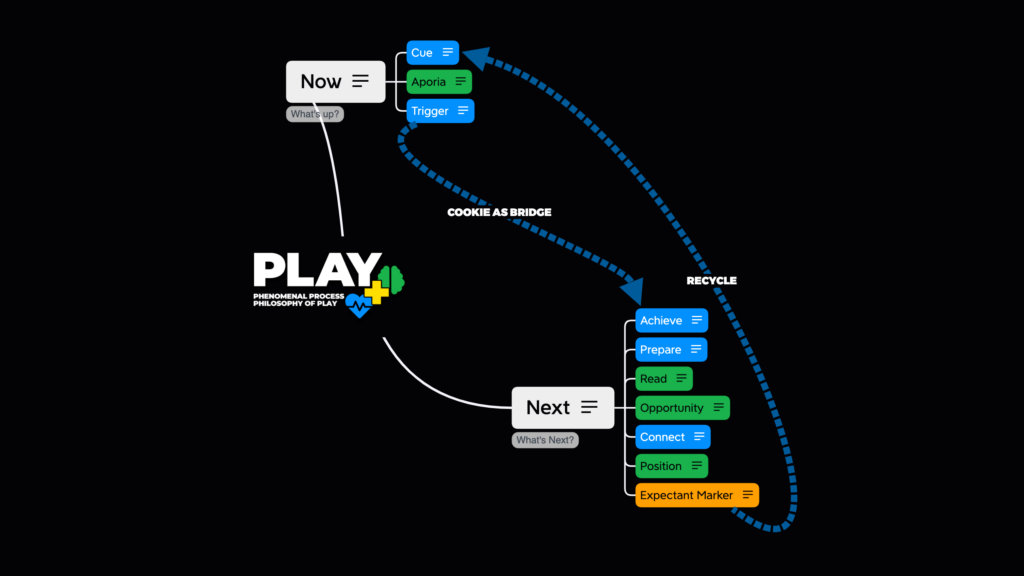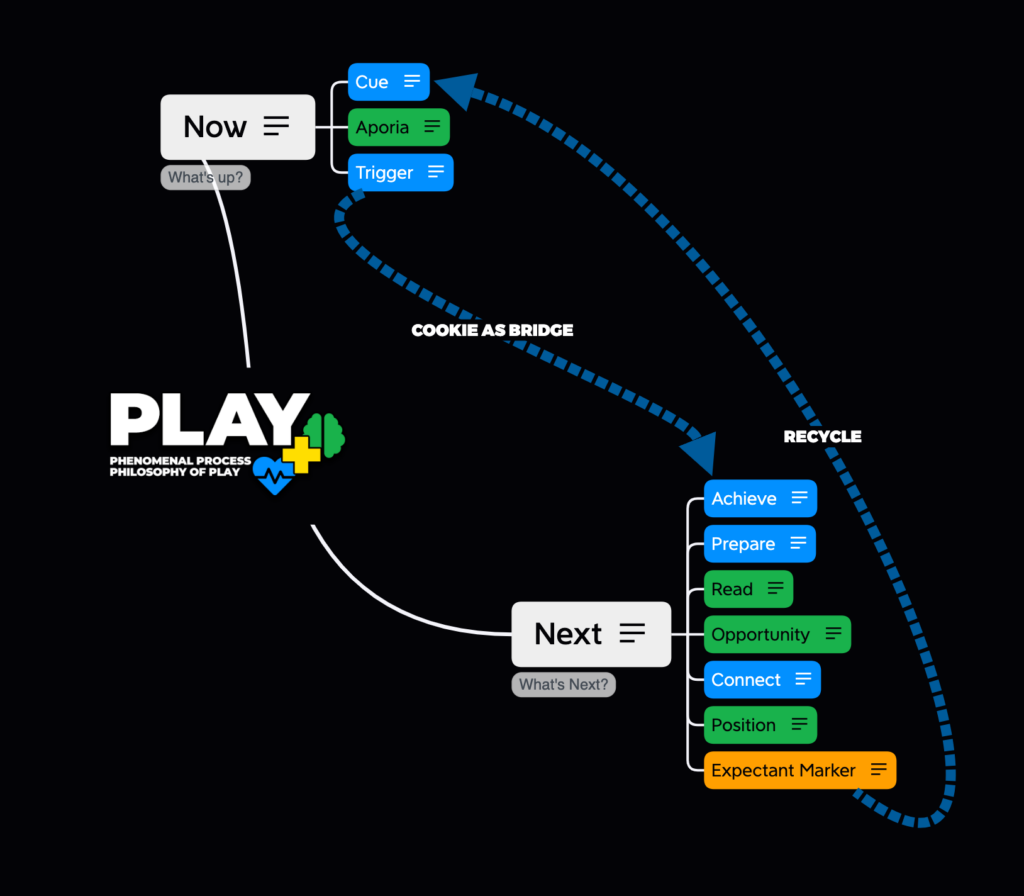
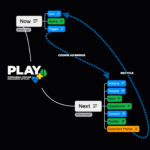 The Now Phase is an integral part of the Play Cycle in the Play+ training philosophy. It embodies the current, immediate interaction between the handler and the dog, anchoring them in the present... More Next"Next" encapsulates the dog's anticipation of a forthcoming reward, sparking motivation and excitement. This expectancy creates a driving force that propels the dog through training, forming a continuous loop of engagement. When "Next"... More Cycle of PlayPlay is willing, self-induced engagement in, and the experience of, novel, consequent opportunity. More: A rhythmic sequence of play in dog training. Now: Cue sparks action… Trigger leads to triumph! Next: Action & Prep create the connection for the Next opportunity of Now. Aporia creates rhythm and thought for the moment and for reflection while loading up expectancy.
The Now Phase is an integral part of the Play Cycle in the Play+ training philosophy. It embodies the current, immediate interaction between the handler and the dog, anchoring them in the present... More Next"Next" encapsulates the dog's anticipation of a forthcoming reward, sparking motivation and excitement. This expectancy creates a driving force that propels the dog through training, forming a continuous loop of engagement. When "Next"... More Cycle of PlayPlay is willing, self-induced engagement in, and the experience of, novel, consequent opportunity. More: A rhythmic sequence of play in dog training. Now: Cue sparks action… Trigger leads to triumph! Next: Action & Prep create the connection for the Next opportunity of Now. Aporia creates rhythm and thought for the moment and for reflection while loading up expectancy.Team’s Perspective
- Cue: The Cue is the Idea, signaling the desired behavior or task to the team.
- Aporia: Aporia is the expectant planning phase, a moment of reflection and preparation, setting the stage for what’s to come.
- Trigger: The moment it happens, the Trigger prompts the team into action, initiating the sequence.
- Action: It’s Now becomes Next – a triumphant letdown as the team actively engages in the behavior or task, working towards their goal.
- Prep: Opportunity is apparent as the team prepares for what lies ahead, seizing the moment to optimize their performance.
- Aporia: A moment that shapes and captures connection, fostering communication and synchronization within the team.
- PositionIn the Play+ philosophy, "Position" is the final stage within the "Next" phase of a Cycle of Play. It acts as a pivotal link between the "Next" phase and a new "Now" phase. More: Through
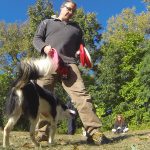 A Through is a set up move where the dog runs between the handler’s legs. The dog can move from front to back or side to side and can even weave. A Through... More team movement, the Position is established, ensuring optimal alignment and coordination.
A Through is a set up move where the dog runs between the handler’s legs. The dog can move from front to back or side to side and can even weave. A Through... More team movement, the Position is established, ensuring optimal alignment and coordination. - Aporia: A time for reflection and reset, allowing the team to gather thoughts, assess progress, and prepare for the next phase.
By embracing each stage of the Cycle of Play, the team establishes a rhythm, maximizing their potential and achieving success through seamless collaboration and communication.
Handler’s Perspective
- Cue: As the handler, you provide the initial cue or signal to the dog, indicating the desired behavior or task.
- Aporia: Take
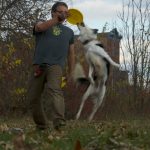 A Take is a cued Bite that replicates the placement and timing of a throw. Usually used with overs, vaults, and flips, the Take is a powerful teaching tool for creating habitual leaping... More a moment to pause and allow the dog to mentally prepare for the upcoming action. This reflection time sets the stage for a focused and engaged training session.
A Take is a cued Bite that replicates the placement and timing of a throw. Usually used with overs, vaults, and flips, the Take is a powerful teaching tool for creating habitual leaping... More a moment to pause and allow the dog to mentally prepare for the upcoming action. This reflection time sets the stage for a focused and engaged training session. - Trigger: Prompt the dog to initiate the action based on the received cue. Your clear and precise cues guide the dog’s behavior and set the training process in motion.
- Action (Getting the CookieA Cookie is traditionally thought of as a food treat given as positive reinforcement. In that definition, a cookie is a discrete piece of food reinforcement. In many dog training discussions, the idea... More): The dog actively engages in the behavior or task prompted by the trigger, which involves obtaining the cookie as the immediate action and goal. Reward the dog promptly and accurately to reinforce the desired behavior.
- Handler preps and gets ready: Adjust your position, load the next reward or prop, and neutrally declare your position and movement. This preparation signals to the dog that the training session is ongoing and helps maintain their attention and focus.
- Handler reads the dog’s release: Observe the dog’s behavior and response as they receive the cookie. Pay attention to their body language, attentiveness, and level of engagement. This insight allows you to assess the dog’s understanding and readiness for the next phase.
- Reflect and regroup: Take a moment to reflect on the training progress and gather your thoughts. Assess the dog’s response and consider any necessary adjustments or refinements in your training approach. This reflection helps ensure effective communication and learning.
- Reconnection: Re-engage with the dog, establishing a connection and aligning your attention and focus. Your responsiveness and engagement strengthen the bond and collaboration between you and the dog.
- Position: Provide cues and guidance to adjust the dog’s physical position and posture. Set them up for success in the next behavior or task, ensuring they are in the optimal position to perform effectively.
- Aporia: Allow a final moment of pause or reflection before the cycle begins anew. This brief break prepares both you and the dog for the next cue and trigger, fostering anticipation and readiness.
Dog’s Perspective
- Cue: Receive the cue from the handler, indicating the desired behavior or task.
- Aporia: Take a moment to process the cue and mentally prepare for the upcoming action. Use this reflection time to focus and get ready for engagement.
- Trigger: Initiate the action prompted by the trigger. Act on the cue with enthusiasm and precision, understanding that it leads to a rewarding experience.
- Action (Getting the Cookie): Actively engage in the behavior or task, which involves obtaining the cookie as the immediate action and goal. Embrace the excitement and anticipation as you work towards the reward.
- Prepare
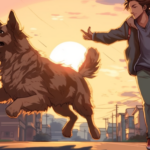 In the Play+ philosophy, "Prep" or Prepare is the 2nd stage of "Next" in a Cycle of Play. It's the moment where the handler readies themselves to become an opportunity for the dog.... More: Experience a sense of readiness and anticipation as you anticipate the outcome or consequence. Your focus sharpens, preparing you for the next phase.
In the Play+ philosophy, "Prep" or Prepare is the 2nd stage of "Next" in a Cycle of Play. It's the moment where the handler readies themselves to become an opportunity for the dog.... More: Experience a sense of readiness and anticipation as you anticipate the outcome or consequence. Your focus sharpens, preparing you for the next phase. - Read
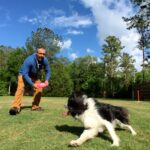 In Play+, "Read Release" refers to the handler's observation and interpretation of the dog's behavior following the completion of an action or behavior. More Release
In Play+, "Read Release" refers to the handler's observation and interpretation of the dog's behavior following the completion of an action or behavior. More Release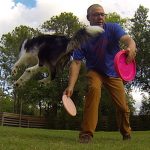 Release has many meanings in disc. Throws and throw variations can be referred to as releases. Sometimes you talk about the dog releasing something, the toy, or the environment, as in to stop... More: Observe the handler’s response as you receive the cookie. Pay attention to their cues and signals, gauging their satisfaction and feedback on your performance.
Release has many meanings in disc. Throws and throw variations can be referred to as releases. Sometimes you talk about the dog releasing something, the toy, or the environment, as in to stop... More: Observe the handler’s response as you receive the cookie. Pay attention to their cues and signals, gauging their satisfaction and feedback on your performance. - Reflect and regroup: Take a moment to reflect and recollect, regrouping your thoughts and emotions. Use this time to process the recent action and mentally reset for the next phase.
- Reconnection: Respond to the handler’s engagement, aligning your attention and focus. Feel the connection and collaboration between you and the handler, knowing that you are working together towards a common goal.
- Position: Adjust your physical position and posture based on the handler’s cues, preparing for the next behavior or task. Be receptive and responsive to their guidance.
- Aporia: Allow a final moment of pause or reflection before the cycle begins anew. Embrace the anticipation and readiness as you prepare for the next cue and trigger, maintaining your engagement and enthusiasm.
By considering both the handler and the dog’s perspectives within the Play Cycle, you can enhance communication, engagement, and training outcomes. This comprehensive understanding fosters a harmonious and effective training relationship, leading to a successful and enjoyable training experience for both parties involved.




